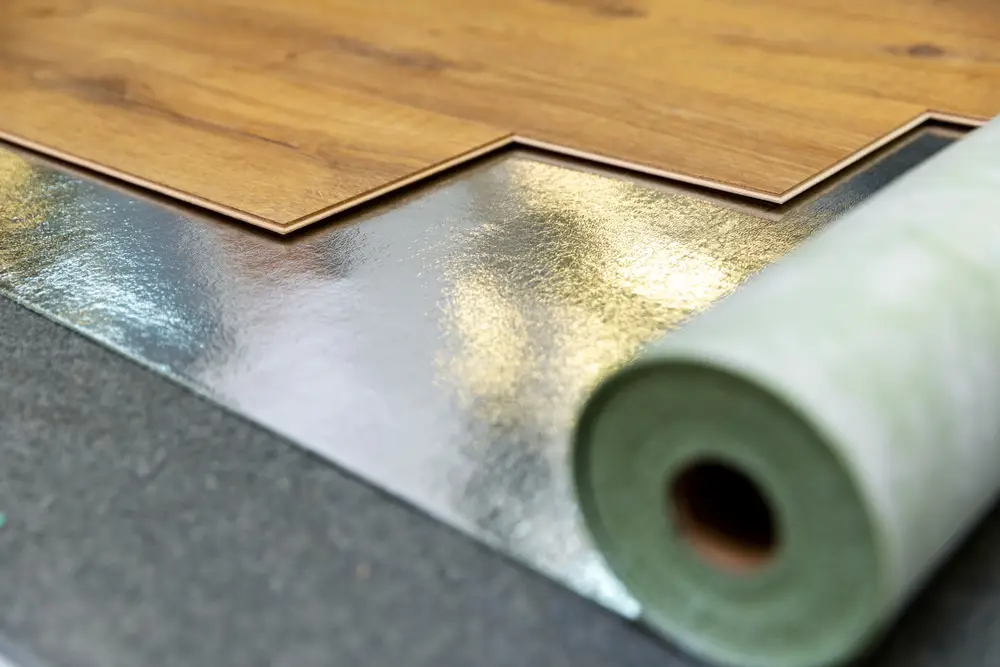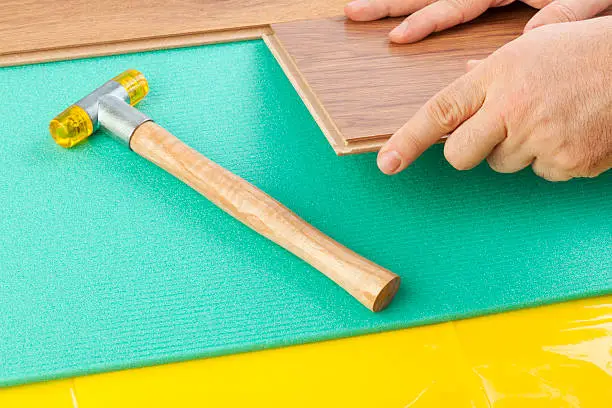Are you considering installing a laminate floor in your home and want to know if adding an underlayment is possible? You may wonder how to prep the area, what materials are needed, or how much time it will take.
Luckily, when you choose a laminate floor with attached padding, installation is more straightforward than other types of floors that don’t come prepped.
In this blog post, we will go over the basics of installing underlayment under lamination with attached padding so that you can make informed decisions about your new floor project.
Read on for tips on preparing the area and easy-to-follow steps for ensuring a quality install!
Laminate flooring consists of several layers, including a bottom layer of padding. This padding is usually attached to the laminate boards but can also be purchased separately.
What Is an Underlayment?
Underlayment is a thin layer of material that is installed between the subfloor and the finished flooring. The most common type of underlayment is made of foam and provides cushioning insulation and noise reduction.
Underlayment is not always necessary, but it can be beneficial, particularly if you are installing laminate with attached padding.
If you are unsure whether or not your laminate flooring needs an underlayment, it is best to consult with the manufacturer or a professional installer.
In general, however, if you are installing laminate with attached padding, it is not necessary to also install an underlayment. The attached padding will provide sufficient cushioning and noise reduction.

Why should You need an underlayment with attached pad flooring?
When it comes to installing new flooring, an underlayment with an attached pad is the perfect choice for providing superior acoustic insulation as well as comfort and soundproofing quality.
An underlayment with an attached pad protects the surface of the floor and reduces impact noise from footfalls, furniture, children, and pets.
Additionally, it absorbs shock from walking or running on harder surfaces like stone, ceramic, or wood. The extra layer of cushioning also provides added warmth to your floors during the winter months.
Investing in an underlayment with an attached pad means you will enjoy superior soundproofing, insulation, and added cushion feel that will extend the life of your floors and make them a more comfortable place to walk in all year round!
Best Underlayment For Attached Pad Flooring
When it comes to the best underlayment for attached pad flooring, it’s important to consider both comfort and performance.
Cork underlayment is often a great choice as it has good noise-dampening abilities and provides cushioning without compromising stability.
It also provides good insulation which helps with energy efficiency. Another great option that can be combined with cork is foam underlayment which offers extra shock absorption and increases sound-reducing ability while also protecting your floor against moisture damage.
No matter what type of underlayment you choose, make sure it will provide your floor with the protection and cushioning it needs to last for years to come!
Related Topic: 8 Common mistakes When Laying Laminate Flooring
Advantages of Underlayment Under Laminate Flooring
Installing laminate flooring has become popular in recent years due to its affordability, durability, and low-maintenance qualities. But to make the most of these properties and ensure that your laminate floor is installed properly, you will need a quality underlayment.
Underlayments are smooth pads that fit directly underneath your laminate flooring, providing a level surface and extra protection against moisture, wear and tear, noise reduction, and more.
The benefits of using an underlayment for your laminate flooring include improved sound absorption compared to wood or tile floors.
The added cushion makes the floor more comfortable on feet, legs, and backs; there is increased insulation offered from temperature change
Moreover, underlayment can help eliminate small imperfections in subfloors.
Types Of Underlayments
When it comes to installing your new flooring, there are many options to consider and one of the important questions to ask is whether to use pre-attached or separate underlayment.
Pre-attached underlayment is already adhered to the underside of certain vinyl and laminate floor planks, while separate types of underlayment must be attached below the floor plan.
While pre-attached may seem like a more straightforward option, there are advantages to using separate layers since it can provide better soundproofing and heat insulation.
This is particularly relevant for homes that experience colder temperatures in winter months.
Using separate underlayment also allows for some extra cushioning and protection in high-traffic areas where subfloor imperfections could cause the floor plank to buckle over time.
However, when deciding which type of underlayment is best for their project, homeowners should do their due diligence to ensure that the piece they choose is appropriately rated for their specific type and location of installation.
Why You Should Use Separate Underlayment?
Separate floor underlayment offers a convenient solution for many of your flooring preparation needs. Constructed from various materials, such as felt, foam, or rubber, these underlayments add comfort and cushion to your flooring.
They absorb sounds and enhance the natural acoustics of the room which reduces noise from foot traffic. Underlayments also increase performance by providing insulation to reduce energy costs and conserve energy.
In addition, many types of these materials can be used with different kinds of floors like wood, vinyl, or carpet, making them an adaptable option that is available for various applications.
Different models provide qualities like waterproof abilities, extra support for heavy furniture pieces, and added protection against moisture damage. Separate floor underlayment is truly a valuable feature that will help you get the most out of your floors.
Why You Should Use the Pre-Attached Underlayment?
Installing a pre-attached floor underlayment is an excellent way to increase the comfort of your flooring while also protecting it. This type of underlayment is popular because it adds cushioning and insulation, providing noise reduction and temperature control.
The improved sound absorption keeps footsteps insulated, resulting in less noise pollution throughout your home. In addition to those features, pre-attached floors also provide water protection for water-prone spaces.
With the added layer of protection, you can rest assured that spills will not seep into your subfloor.
All in all, installing pre-attached floor underlayment offers more than just comfort; it offers added protection for your flooring that no other kind of installation offers.
Conclusion
In most cases, you will not need to install an underlayment if you are installing laminate with attached padding. The attached padding will provide sufficient cushioning and noise reduction.
However, it is always best to consult with the manufacturer or a professional installer to be sure.
Related Topic: Vinyl vs Laminate Flooring Pros and Cons: Ultimate Guide
FAQs
Can you use 2 layers of underlay under vinyl flooring?
Yes, you can use two layers of underlay beneath vinyl flooring. Doing so creates a more cushiony feel, which helps to protect the vinyl from furniture and traffic wear and tear. It will also improve the overall soundproofing and insulation of your home or office.
Additionally, using an extra layer provides more stability – ensuring that vinyl planks are less likely to move around or buckle over time due to changes in temperature and humidity levels.
Ultimately, when it comes to luxury vinyl floorings, adding extra layers of underlayment is always a good idea for the best look, feel, and protection for your space.
What happens if you don’t put underlayment under laminate flooring?
Failing to install an appropriate underlayment under your laminate floor may result in disastrous long-term effects. Without an underlayment, your laminate flooring is less likely to expand and contract as the temperature changes; this means it may warp or buckle due to the added pressure leading to creased edges that become highly visible lines on the surface.
Additionally, the underlayment acts like a moisture barrier, which absorbs any excess moisture or spills and ensures the laminate’s longevity; if the excess moisture touches directly onto your laminate flooring, discoloration or mold growth can occur over time.
Installing an appropriate underlayment when laying down your new laminate flooring will not only create a smoother and more quiet experience when walking on it but also protects it from potential impact damage.
Do you need underlayment for laminate flooring on concrete?
Installing laminate flooring on concrete can be a straightforward and budget-friendly process. It’s important to consider whether or not you need underlayment for the laminate flooring, as this material can provide additional insulation and soundproofing benefits beneath the flooring.
Many types of laminate come with their own built-in underlayment, which makes it unnecessary to purchase an extra layer if your particular flooring comes with its own underlayment attached.
If this is not the case, it’s recommended to invest in an appropriate foam or felt underlayment that will ensure maximum comfort and soundproofing while also protecting existing floors from moisture damage.
Ultimately, deciding whether or not to use a separate underlayment layer depends on personal preference and what kind of laminate is being used.


Greetings! Very helpful advice within this article!It’s the little changes that will make the largest changes.Thanks a lot for sharing!
Major thanks for the blog.Really looking forward to read more. Awesome.